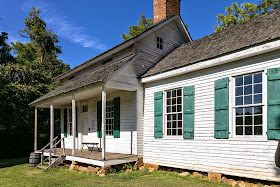Having seen a few pieces of Catawba pottery, we wanted to see more and to learn more about the people who made it. The
Native American Studies Center in Lancaster, SC, was the place to start.
Possibly the world's largest collection of Catawba pottery is housed in the 15,000-square-foot facility. Tending and teaching about it and its makers are an archivist, artist, folklorist, linguist and archaeologist, all faculty members of the University of South Carolina, Lancaster.
Their mission, "to promote the documentation, preservation, appreciation and study of Native American cultures and heritages."
 |
| Chris Judge and a few of the Center's 1,300 Catawba pots. |
Assistant Director
Chris Judge showed us around, pointing out some of their best Catawba pots. All are made from the coil method, the same way we all learned in grammar school, then formed and burnished using river stones, mussel shells, corn cobs and deer antlers as tools. Black was the only color they could control in the firing process.
 |
| Haigler pot. |
"We think this is the oldest pottery tradition in the United States," said Judge.
 |
| Haigler pots. |
Many of the Catawba pots have faces on them and are referred to as Haigler pots.
King Haigler was the beloved and still revered chief (1750-1763) whose diplomacy kept the Catawba traditions intact during increasing migrations of settlers into their lands.
 |
| Double-spouted pot, center right. |
The double-spouted pots represented the bride on one side, the groom on the other. When dropped, the number of pieces the pot broke into represented the number of children the couple would have.
Although there are 13 recognized tribes in South Carolina, the Catawba, or "People of the river," is the only one federally recognized.
As usual, we found ourselves wishing we lived closer so we could take advantage of this wonderful facility with its monthly lunch and learn sessions and the periodic sales of contemporary Catawba pottery (Dec. 6, 2014).
Next it was time to visit the source, the
Catawba Indian Reservation in York County. We were met at the
Cultural Center by
Beckee Garris, who had been born on the reservation and now works for tribal historic preservation and the facility.
 |
| Beckee Garris and a traditional bark house at the Catawba Cultural Center. |
The Center, a reservation school until 1969 when the state fully integrated education, is a community center for residents and houses a store of Indian products and a reconstructed traditional bark house.
Also on the reservation is a high-stakes bingo hall. Of the 3,000 Catawba in the area, 1,200 to 1,800 live on the reservation; 99 percent work off of it.
Theirs is the typically grossly unfair story of government mismanagement and ignored treaties. The government "bought" their land for $50 an acre, but the tribe may buy it back at fair market value, anywhere from $12,000 to $500,000 an acre.
The tribe's last sacred clay hole, which tribal story tellers say has been used for more than 400 years, is on non-native-held land. Fortunately, the owner allows them to dig several times a year. Scientists tell them Catawba pots have been coming from it for 5,000 years.
When
Winona Haire, a dentist and tribe member, arrived we heard of the tribe's plans for the future, primarily to construct a living Catawba village. It has taken almost 4 years to finish the palisade - "It's not like going to Lowe's," said Haire - and a heritage garden has been started.
 |
| Catawba heritage garden |
We got a glimpse of this outside the Center where the red okra was about to finish its season. Neither prickly nor green like the African variety, this native plant isn't slimy either. Everything is being replaced with native heritage seeds from corn and tomatillos to chocolate bell peppers.
 |
| Native red okra |
One thing the tribe doesn't teach outsiders is its pottery skills. That would be like giving away their heritage, according to Haire.
"We've got a lot of things in the hopper, it just takes time," she said.
Kind of like the Good Girls' task of trying to see it all.




































